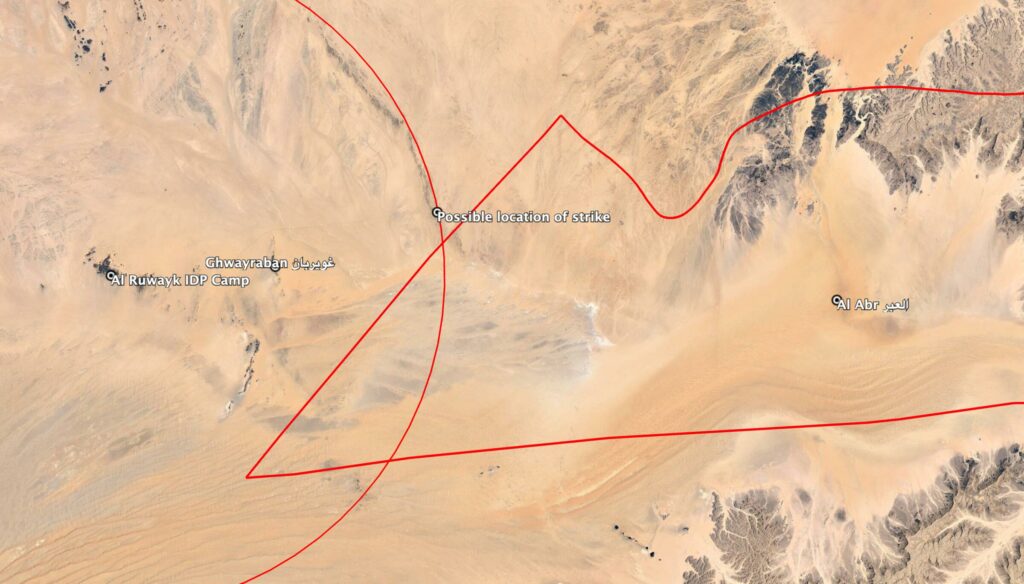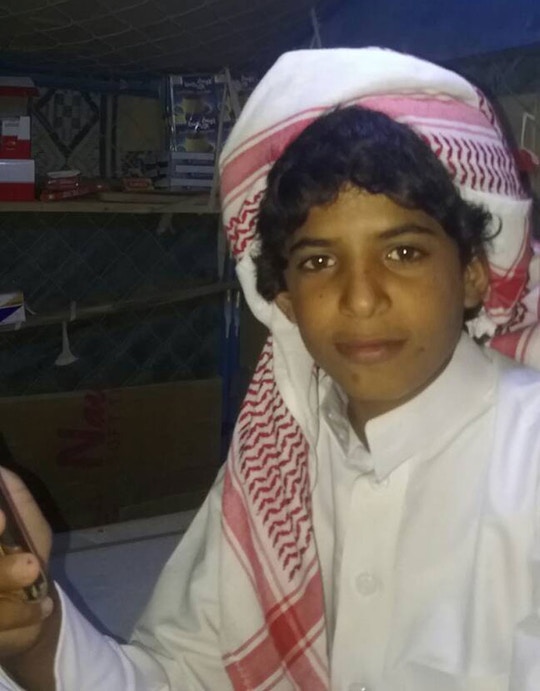Incident Code
Incident Date
Location
Geolocation
Geolocation
Airwars Assessment
(Previous Incident Code: YEM303)
A child was reported killed, and his older cousin injured, by a likely US drone strike in Al Abr, in Hadramout governorate, at around 4pm on March 5th 2018.
A US Central Command spokesperson later told the Long War Journal that a strike had taken place in Hadramout on that date. CENTCOM also told the Bureau of Investigative Journalism that allegations of civilian harm in this strike had been deemed ‘non-credible’, due to a lack of available evidence.
According to investigations by Mwatana for Human Rights and The Intercept, Amer Ali al-Saqra Huraidan and his older cousin, Hasan, were targeted as they drove home to Marib governorate, after taking relatives to a funeral in al-Hudhi, in Hadramout. According to these sources, Hasan was severely wounded on his right hand, leg, and head, while Amer was killed instantly by the strike.
Local sources denied to The Intercept that Amer or Hasan were members of either AQAP or ISIS. Hasan said that “[Amer] was too young to join [any militant groups]”, and Amer’s uncle, Amer Saleh Huraidan, also told The Intercept that there was “no link with Al Qaeda whatsoever”. Both Mwatana and The Intercept reported that Hasan was a soldier in the Yemen military, but that he was not on deployment at the time of the strike. Writing in The Guardian, Yemeni Human Rights Minister Mohamed Askar said that a government committee had collected evidence that those targeted were civilians.
Reporting on the ages of the victims was variable. Mwatana gave the ages of Amer and Hasan as twelve and 17 respectively. According to The Intercept, Amer was thirteen and Hasan was 19, while Associated Press reported that Amer was ten. One Twitter source, @abdrabboh_79, suggested that Amer was eleven at the time of the strike. Given this, it is possible that Hasan was also a child at the time of the strike.
Reprieve shared their findings on this strike with Airwars. An on-the-ground investigator reported that a thirteen-year-old was killed, and an eighteen-year-old injured, in the strike.
Baraa Shiban, a Reprieve caseworker, told The Intercept that Amer and his family were Internally Displaced Persons, and, at the time of the strike, were living in tents by an oil field, having fled fighting in Al-Jawf. Mwatana spoke with Amer’s teacher, who said that he was a “very, very good child”. His mother told Mwatana that he “would come home from school to help her with chores”. According to The Intercept, Amer is survived by five siblings.
Amer’s family members told reporters and investigators of their desire for justice and compensation. “We condemn criminal acts from any party, be it from Muslims or non-Muslims. If you take a look at their status in tents, they need relief — electricity, water, food — and not bombing,” Amer’s uncle told The Intercept. One relative told Mwatana that “If we keep silent about this crime, the number of similar strikes against innocent people will increase”.
A local activist told The Intercept that some members of the Al-Mahashima tribe, to which the alleged strike victims belonged, were members of AQAP, and said that Hasan “may have met some members of AQAP”, but he was not himself a member. A Yemeni intelligence official, however, indicated that those members of the tribe had been killed a considerable time ago.
Members of the Al-Mahashima tribe were the target of at least two further alleged US drone strikes in the area during March 2018. In an email to Long War Journal, US Central Command stated that two strikes had taken place on March 4th in Hadramout, and one on March 5th. Given that two other strikes (USYEMTr150, USYEMTr151) that possibly took place on March 5th have been treated by Airwars as the declared March 4th events, this event is treated as the declared March 5th strike.
A local security official told Xinhua that four AQAP militants had been killed by a US drone strike against “a moving vehicle” on March 6th. Given that no other known sources reported a unique strike on that day, this potentially reflects a late report of this strike and/or other reported strikes at around the same time (USYEMTr150/USYEMTr151). This single-source allegation is also captured in a separate event (USYEMTr153).
In its annual civilian casualty report to Congress issued in April 2019, the US Department of Defense stated that it had assessed “no credible reports of civilian casualties resulting from US military actions in Yemen during 2018″.
Responding to Airwars’ publication of its Yemen dataset and accompanying report in October 2020, CENTCOM dismissed all but two civilian harm claims under President Trump, asserting that “USCENTCOM conducted a thorough review of the information AirWars provided regarding allegations of potential civilian harm caused by USCENTCOM strikes in Yemen from 2017-2020… The bulk of the information asserted by AirWars, however, did not correspond with dates and locations of U.S. military strikes or raids in Yemen. Other AirWars allegations either did not allege civilian harm or were not assessed as credible upon our review.”
In March 2021 in its report Death from the Sky, Mwatana published a comprehensive review of the event, which it said was based upon “two visits to the area, one on March 15, 2018—about ten days after the strike—and another on October 16, 2019. Mwatana interviewed five people: Hassan (the boy who was wounded), three relatives of the boys, and the teacher of Amer, the 12-year-old boy who was killed. In some cases, Mwatana conducted follow-up interviews to gather further information.”
The report noted: “The strike killed 12-year-old Amer and destroyed the pick-up truck. Hassan [aged 17] said that he was hit with fragments in different parts of his body, including his head, his stomach, and his arm, thigh, and leg on the right side of his body. Hassan lost consciousness and was taken to Karaa Hospital in Ma’rib governorate by a woman and an old man who had driven past Hassan and Amer after the attack. Hassan said he woke up in the hospital. The hospital treated his wounds, which included a few operations to remove the shrapnel from his body and to treat the wounds in his legs and hands. He stayed in the hospital for about a month and then stayed at home in recovery for a few months.”
Key Information
Geolocation Notes
Reports of the incident mention a vehicle being struck in the vicinity of Al Abr (العبر), approximately 60km from the Al Ruwayk IDP camp, west of Ghwayraban (غويربان), the generic coordinates for this possible location are: 16.039178, 46.632381. Due to limited satellite imagery and information available to Airwars, we were unable to verify the location further.

Reports of the incident mention a vehicle being struck in the vicinity of Al Abr (العبر), approximately 60km from the Al Ruwayk IDP camp, west of Ghwayraban (غويربان).
Imagery: Google Earth

